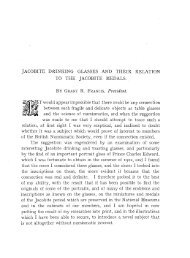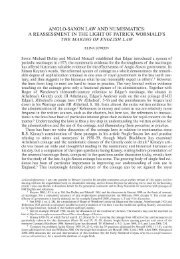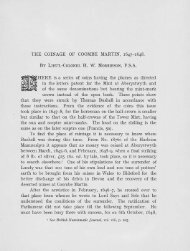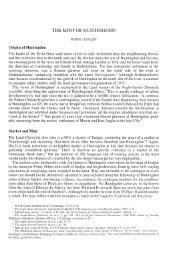a re-examination of a gold medal awarded to major rogers for ...
a re-examination of a gold medal awarded to major rogers for ...
a re-examination of a gold medal awarded to major rogers for ...
Create successful ePaper yourself
Turn your PDF publications into a flip-book with our unique Google optimized e-Paper software.
A RE-EXAMINATION OF A GOLD MEDAL AWARDED<br />
TO MAJOR ROGERS FOR VALOROUS SERVICES<br />
IN 1690<br />
O L I V E R C R E S S W E L L<br />
FIG. 1. (Actual size 1-3 inches.)<br />
THE <strong>medal</strong>, the subject <strong>of</strong> this paper, which is illustrated above, was first described by<br />
Charles Winter in volume xx <strong>of</strong> this Journal, pp. 261-2. Mr. Winter suggests that the<br />
<strong>medal</strong> was granted <strong>to</strong> Major Rogers <strong>for</strong> his valorous services in an operation during the<br />
Battle <strong>of</strong> the Boyne when the Enniskilleners we<strong>re</strong> surprised at a place called Plottin<br />
Castle, a mile and a half from the field, and routed by the Irish Horse, who in turn we<strong>re</strong><br />
ultimately compelled <strong>to</strong> give way and flee. He points out that Derry and Inniskilling<br />
we<strong>re</strong> the only two places favouring the coming <strong>of</strong> William.<br />
Winter's account, the only <strong>re</strong>cord in print <strong>of</strong> this <strong>medal</strong>, is both brief and ill conside<strong>re</strong>d.<br />
It will suffice at this point <strong>to</strong> indicate that he has confused the Inniskilling Horse with<br />
the Inniskilling Foot as the following account <strong>of</strong> the Battle <strong>of</strong> the Boyne from the<br />
His<strong>to</strong>ry <strong>of</strong> the 5th Royal Irish Lancers will show.
GOLD MEDAL AWARDED TO MAJOR ROGERS 139<br />
At Platin House, halfway between Dono<strong>re</strong> and Duleek, General Hamil<strong>to</strong>n had drawn up a body <strong>of</strong><br />
Irish cavalry in a field, in<strong>to</strong> which a gap from a by-road was the only entrance. Eight troops <strong>of</strong> Enniskilleners<br />
under Wolseley came riding along this by-road in advance <strong>of</strong> the army, and two troops<br />
promptly ente<strong>re</strong>d the field. Wolseley orde<strong>re</strong>d the men, by mistake, <strong>to</strong> <strong>for</strong>m <strong>to</strong> the right, thus bringing<br />
the men with their backs <strong>to</strong> the enemy. Orders <strong>to</strong> wheel <strong>to</strong> the right we<strong>re</strong> given, but the <strong>re</strong>sult was<br />
confusion. The Irish charged, and cutting down some fifty troopers, drove the others pell mell on <strong>to</strong> the<br />
crowded troops in the lane, who we<strong>re</strong> quite incapable <strong>of</strong> <strong>re</strong>sistance and we<strong>re</strong> chased out <strong>of</strong> the lane.<br />
FIG. 2.<br />
As the<strong>re</strong> has been a g<strong>re</strong>at inc<strong>re</strong>ase in the number <strong>of</strong> <strong>medal</strong> collec<strong>to</strong>rs in <strong>re</strong>cent years<br />
perhaps the following mo<strong>re</strong> detailed appraisal <strong>of</strong> this <strong>medal</strong> would be <strong>of</strong> inte<strong>re</strong>st. This<br />
<strong>medal</strong> is mo<strong>re</strong>over <strong>of</strong> importance in so far as, if authentic, it is one <strong>of</strong> the earliest <strong>of</strong><br />
British War Medals and possibly the earliest named <strong>medal</strong>. It could also be <strong>re</strong>garded<br />
as the ances<strong>to</strong>r <strong>of</strong> the engraved <strong>re</strong>gimental <strong>medal</strong> <strong>of</strong> the period 1790-1815, a class <strong>medal</strong><br />
highly prized both by private collec<strong>to</strong>rs and by <strong>re</strong>gimental museums. It is important<br />
the<strong>re</strong>fo<strong>re</strong> befo<strong>re</strong> it is <strong>re</strong>garded as authentic and used as a <strong>to</strong>uchs<strong>to</strong>ne <strong>to</strong> judge other<br />
<strong>medal</strong>s that it be subjected <strong>to</strong> a thorough <strong>examination</strong>.<br />
Obverse. Bust, lau<strong>re</strong>ated, <strong>to</strong> right. Legend, WILLIAM THE III: D (?) GR: REX: FID: DEF:<br />
1690.<br />
Going on the assumption that this <strong>medal</strong> is a product <strong>of</strong> the last decade <strong>of</strong> the seventeenth<br />
century we a<strong>re</strong> faced with a number <strong>of</strong> inconsistencies. First, the method <strong>of</strong><br />
manufactu<strong>re</strong> is not a usual one <strong>for</strong> the period. The <strong>medal</strong>s <strong>of</strong> the period up <strong>to</strong> about<br />
1650 a<strong>re</strong> either cast or made by hammering thin plates <strong>of</strong> metal in<strong>to</strong> a mould. These<br />
methods we<strong>re</strong> used <strong>to</strong> by-pass the difficulty <strong>of</strong> striking by the usual dies, as the art <strong>of</strong><br />
making dies and the imperfect machinery employed did not allow the use <strong>of</strong> high <strong>re</strong>lief.<br />
After the mid-seventeenth century the improvements in die manufactu<strong>re</strong> enabled the<br />
mo<strong>re</strong> economical and speedy modern method <strong>to</strong> be applied and so the casting or hammering<br />
<strong>of</strong> thin plates in<strong>to</strong> a mould, or <strong>re</strong>pousse as it is called, became obsolete. The<br />
workmanship <strong>of</strong> the <strong>medal</strong> in question is so poor that it is impossible <strong>to</strong> attribute it <strong>to</strong><br />
any <strong>of</strong> the fo<strong>re</strong>most <strong>medal</strong>lists <strong>of</strong> the period and the <strong>medal</strong> must be a copy <strong>of</strong> the work<br />
<strong>of</strong> one <strong>of</strong> them. The bust approaches most nearly <strong>to</strong> that used by Johannes Smeltzing<br />
in 1690 alluding <strong>to</strong> the calming down <strong>of</strong> the Dutch discontents in Amsterdam (Fig. 2).
140 A RE-EXAMINATION OF A GOLD MEDAL AWARDED TO<br />
While the English legend points <strong>to</strong> a British origin <strong>for</strong> the <strong>medal</strong> the<strong>re</strong> is another point<br />
which would indicate a continental pro<strong>to</strong>type. This is the appearance in the legend <strong>of</strong><br />
the title Defender <strong>of</strong> the Faith.<br />
The title 'Defender <strong>of</strong> the Faith' was confer<strong>re</strong>d on Henry VIII by Pope Leo X in 1521<br />
and has been borne ever since by the sove<strong>re</strong>igns <strong>of</strong> England and the United Kingdom.<br />
However, while the title was borne, it did not make its appearance on the coinage until<br />
the time <strong>of</strong> George I and then in the abb<strong>re</strong>viation F.D., while the fuller <strong>for</strong>m appea<strong>re</strong>d in<br />
the time <strong>of</strong> George III. On <strong>of</strong>ficial war <strong>medal</strong>s it is strange <strong>to</strong> note that the title has only<br />
appea<strong>re</strong>d twice; on the New Zealand war <strong>medal</strong> <strong>for</strong> service in the Maori Wars <strong>of</strong> 1845-7<br />
and 1860-6 and mo<strong>re</strong> <strong>re</strong>cently on the Defence Medal issued after the Second World War<br />
in 1945.<br />
On his<strong>to</strong>rical <strong>medal</strong>s the title appears much earlier and mo<strong>re</strong> <strong>re</strong>gularly. Its first appearance<br />
was on a <strong>medal</strong> <strong>of</strong> Henry VIII, illustrated on PI. 5 <strong>of</strong> Medallic Illustrations. It also<br />
appears on another <strong>medal</strong> <strong>of</strong> this <strong>re</strong>ign commemorating the <strong>re</strong>cognition <strong>of</strong> Henry as<br />
sup<strong>re</strong>me head <strong>of</strong> the Church <strong>of</strong> England. The title was used by Edward VI on a <strong>medal</strong><br />
marking his coronation and in the <strong>re</strong>ign <strong>of</strong> Mary it appears mo<strong>re</strong> f<strong>re</strong>quently. One <strong>of</strong> the<br />
most inte<strong>re</strong>sting appearances is on the coinage <strong>of</strong> Naples in 1554 showing that Philip II<br />
<strong>of</strong> Spain, the husband <strong>of</strong> Mary, also assumed the title. Perhaps because the title smacked<br />
<strong>of</strong> the Papacy, Elizabeth, who depended on Protestant support in her struggle with<br />
Spain, did not use it on her <strong>medal</strong>s at all.<br />
The Stuart sove<strong>re</strong>igns used the title on <strong>medal</strong>s with some <strong>re</strong>gularity and its first<br />
appearance is on a copper badge, cast and chased, appa<strong>re</strong>ntly issued <strong>for</strong> services in some<br />
naval combat. Charles I used the title <strong>re</strong>peatedly on <strong>medal</strong>s and it seems <strong>to</strong> be a favourite<br />
legend on the Royalist badges <strong>of</strong> the period <strong>of</strong> the Civil Wars. Charles II used it only<br />
twice on <strong>medal</strong>s; on the <strong>medal</strong> commemorating his coronation in Scotland, and on a<br />
<strong>medal</strong> by Thomas Simon <strong>for</strong> the English coronation in 1661. Surprisingly enough<br />
James II, the most <strong>for</strong>thrightly Catholic <strong>of</strong> the Stuarts, did not use the title on <strong>medal</strong>s<br />
at all. William III used it from the first landing in England but the <strong>medal</strong>s bearing the<br />
title a<strong>re</strong> the work <strong>of</strong> the Dutch artists Jan Smeltzing and Jan Luder, and <strong>of</strong> the German<br />
<strong>medal</strong>lists George Hautsch and Martin Brunner. The only British artist <strong>to</strong> use this title<br />
is F. D. Winter who copied the <strong>medal</strong>s <strong>of</strong> Jan Smeltzing. The<strong>re</strong> is a <strong>medal</strong> illustrated on<br />
PI. 86 <strong>of</strong> Medallic Illustrations commemorating the Battle <strong>of</strong> Aughrim simply signed<br />
D. S. which also uses the title but this is obviously a copy <strong>of</strong> a Dutch obverse.<br />
The use the<strong>re</strong>fo<strong>re</strong> <strong>of</strong> the title Defender <strong>of</strong> the Faith on a <strong>medal</strong> <strong>of</strong> British manufactu<strong>re</strong><br />
<strong>of</strong> the last decade <strong>of</strong> the seventeenth century would seem improbable. However, if the<br />
period <strong>of</strong> manufactu<strong>re</strong> is moved <strong>for</strong>ward <strong>to</strong> the last decade <strong>of</strong> the next century, as many<br />
points listed later in this paper would indicate, the use <strong>of</strong> this title would seem mo<strong>re</strong><br />
appropriate.<br />
The lettering on both obverse and <strong>re</strong>verse would bear out the contention that he<strong>re</strong><br />
we have the work <strong>of</strong> a provincial <strong>gold</strong>smith in that it is not skilful. This is partially shown<br />
by the archaic <strong>for</strong>m <strong>of</strong> certain letters (notably the sloped serifs <strong>of</strong> E, G, and s.). On<br />
stylistic grounds the lettering can be assigned <strong>to</strong> a period hardly earlier than 1740 and<br />
probably not later than 1800. Taking in<strong>to</strong> account the fact that the poor workmanship<br />
indicates the work <strong>of</strong> a provincial <strong>gold</strong>smith, the lettering would seem <strong>to</strong> point <strong>to</strong> a date<br />
about the last decade <strong>of</strong> the eighteenth century.<br />
If the <strong>medal</strong> is the work <strong>of</strong> a provincial silversmith or jeweller in the last decade <strong>of</strong>
MAJOR ROGERS FOR VALOROUS SERVICES IN 1690 141<br />
the eighteenth century it may seem <strong>of</strong> little value <strong>to</strong> try <strong>to</strong> discover the silversmith<br />
<strong>re</strong>sponsible. However, a <strong>re</strong>fe<strong>re</strong>nce <strong>to</strong> Jackson's book, English Goldsmiths and Their<br />
Marks shows in the list <strong>of</strong> provincial silversmiths and jewellers <strong>re</strong>giste<strong>re</strong>d in the Books<br />
<strong>of</strong> the Company <strong>of</strong> Silversmiths in Dublin in compliance with the Acts 23 and 24 <strong>of</strong><br />
George III (I<strong>re</strong>land) the name <strong>of</strong> Charles McCalvey <strong>of</strong> Enniskillen in 1784. While the<strong>re</strong><br />
can be no pro<strong>of</strong> <strong>of</strong> this, McCalvey does meet the <strong>re</strong>qui<strong>re</strong>ments <strong>of</strong> both time and place.<br />
Reverse. Castle with flag blowing <strong>to</strong> the left. Foliage appears within the walls and is<br />
growing through the embrasu<strong>re</strong>s. Legend, THE ENNISKILLENERS.<br />
As with the obverse the first imp<strong>re</strong>ssion is <strong>of</strong> the poverty <strong>of</strong> the workmanship, even<br />
poo<strong>re</strong>r indeed than that <strong>of</strong> the obverse. This may be <strong>re</strong>adily explained by the probability<br />
that the modelling <strong>of</strong> the castle is original while the bust has been copied from another<br />
<strong>medal</strong>.<br />
The first point <strong>of</strong> inte<strong>re</strong>st is that the castle depicted is meant <strong>to</strong> <strong>re</strong>p<strong>re</strong>sent Enniskillen<br />
Castle and in all probability the Water Gate. A glance at the map will show that Enniskillen<br />
occupies a position <strong>of</strong> g<strong>re</strong>at strategical importance guarding the crossing point<br />
between Upper and Lower Lough Erne. Such a point would have been <strong>for</strong>tified at an<br />
early date and indeed in the early years <strong>of</strong> the sixteenth century a stronghold <strong>of</strong> the<br />
Magui<strong>re</strong>s was e<strong>re</strong>cted he<strong>re</strong>. In 1585 the land <strong>of</strong> I<strong>re</strong>land was divided in<strong>to</strong> Shi<strong>re</strong>s and<br />
Fermanagh was placed under a certain Sheriff Willis. The shi<strong>re</strong> was, however, only in<br />
existence on paper and could not become a <strong>re</strong>ality until the Magui<strong>re</strong> stronghold at Enniskillen<br />
was <strong>re</strong>duced. In 1594 the English troops under Captain John Dowdall s<strong>to</strong>rmed<br />
the castle by means <strong>of</strong> a trick <strong>re</strong>miniscent <strong>of</strong> the Trojan Horse. Sir William Cole, Kt.,<br />
was granted 1,000 ac<strong>re</strong>s in 1611 and in the following year he <strong>re</strong>ceived an additional 320<br />
ac<strong>re</strong>s which included 80 ac<strong>re</strong>s in the <strong>to</strong>wn <strong>of</strong> Enniskillen. As was usual in such cases he<br />
was <strong>re</strong>qui<strong>re</strong>d <strong>to</strong> e<strong>re</strong>ct a castle <strong>to</strong> protect his holding and the old castle was <strong>re</strong>pai<strong>re</strong>d.<br />
It is from this <strong>re</strong>construction that the Water Gate dates though it may contain traces <strong>of</strong><br />
the earlier Magui<strong>re</strong> stronghold. During the English Civil War, which in I<strong>re</strong>land typically<br />
<strong>to</strong>ok on a <strong>re</strong>ligious aspect, Sir William Cole held the castle as a place <strong>of</strong> <strong>re</strong>fuge <strong>for</strong><br />
Protestants from the surrounding counties and raised a <strong>re</strong>giment in 1643, which he led<br />
with considerable success in many small actions now <strong>for</strong>gotten.<br />
In the time <strong>of</strong> Sir William Cole's grandson, Sir Michael Cole, Kt., the <strong>to</strong>wn <strong>of</strong><br />
Enniskillen achieved national importance as being, with Londonderry, the only <strong>to</strong>wn<br />
in I<strong>re</strong>land <strong>to</strong> hold out <strong>for</strong> the Williamite cause. Gustavus Hamil<strong>to</strong>n was elected Governor<br />
and under his lead the citizens raised no fewer than six <strong>re</strong>giments, th<strong>re</strong>e each <strong>of</strong> horse and<br />
foot, <strong>for</strong> the defence <strong>of</strong> the <strong>to</strong>wn. Such well-trained soldiers we<strong>re</strong> welcome indeed and<br />
all six <strong>re</strong>giments we<strong>re</strong> incorporated in<strong>to</strong> the British Army, the first commissions being<br />
granted by Major-General Kirke. These six <strong>re</strong>giments we<strong>re</strong> as follows:<br />
1. Wolseley's Horse. This <strong>re</strong>giment was disbanded after the close <strong>of</strong> the campaigns in<br />
I<strong>re</strong>land and a tradition <strong>re</strong>corded by John Smet, M.D., says that from the disbanded<br />
troopers was raised the <strong>re</strong>giment that later became the 8th Royal Irish Hussars, now<br />
amalgamated with the 4th Hussars as the Queen's Royal Irish Hussars. Tradition he<strong>re</strong><br />
probably contains mo<strong>re</strong> than an element <strong>of</strong> the truth as Henry Cunningham or Conyngham,<br />
the first Colonel <strong>of</strong> the 8th Hussars was a son <strong>of</strong> the Sir Albert Conyngham who<br />
raised the <strong>re</strong>giment Conyngham's Dragoons and had served as a Captain in Forbe's<br />
Regiment <strong>of</strong> Foot, later the 18th Foot, the Royal Irish Regiment.
142 A RE-EXAMINATION OF A GOLD MEDAL AWARDED TO<br />
2. Conyngham's Dragoons. This <strong>re</strong>giment was raised mostly from County Donegal<br />
men, many <strong>of</strong> whom we<strong>re</strong> sons <strong>of</strong> Cromwell's veterans settled in the district. Sir Albert<br />
Conyngham lost his life at Colooney in 1691. Robert Echlin became the next Colonel<br />
with the Henry Cunningham mentioned above as Lieutenant-Colonel and the <strong>re</strong>giment<br />
began an uninterrupted ca<strong>re</strong>er <strong>of</strong> over 200 years on the Army list. Today it has been<br />
amalgamated with the 5th Dragoon Guards as the 5th Royal Inniskilling Dragoon<br />
Guards. During its separate life as the 6th Inniskilling Dragoons it gained many battle<br />
honours, including Dettingen, Waterloo, and Balaklava.<br />
3. Wynne's Dragoons. This <strong>re</strong>giment was taken on the st<strong>re</strong>ngth <strong>of</strong> the British Army<br />
by a royal warrant on the 1st <strong>of</strong> January 1689 and <strong>for</strong> just over a century as the 5th Royal<br />
Irish Dragoons served as part <strong>of</strong> that army. During the 1798 Rebellion ca<strong>re</strong>less <strong>re</strong>cruiting<br />
<strong>re</strong>sulted in the <strong>re</strong>giment taking in<strong>to</strong> its ranks some very un<strong>re</strong>pentant <strong>re</strong>bels. A mutiny<br />
was planned, nipped in the bud and the <strong>re</strong>giment disbanded. For sixty years the gap in<br />
the Army List <strong>of</strong> cavalry <strong>re</strong>giments <strong>re</strong>mained unfilled until the <strong>for</strong>mation <strong>of</strong> the 5th Royal<br />
Irish Lancers. This <strong>re</strong>giment was <strong>re</strong>garded as the successor <strong>of</strong> the disbanded <strong>re</strong>giment<br />
and assumed their Battle Honours <strong>of</strong> Blenheim, Ramillies, Oudenarde, and Malplaquet,<br />
<strong>to</strong> which they shortly added some <strong>of</strong> their own. In 1922 amalgamation with the 16th<br />
Lancers <strong>to</strong>ok place and <strong>to</strong>day the <strong>re</strong>giment, armou<strong>re</strong>d like all <strong>for</strong>mer cavalry units, is<br />
listed as the 16th/5th Lancers.<br />
4. Tiffin's or Tiffan's Regiment <strong>of</strong> Foot. Zachariah Tiffin <strong>re</strong>ceived his commission as<br />
Colonel <strong>of</strong> this portion <strong>of</strong> the Enniskillen <strong>for</strong>ces in June 1689 and commanded the <strong>re</strong>giment<br />
in I<strong>re</strong>land and the Low Countries until his death in Antigua in 1701. The <strong>re</strong>giment<br />
has had an uninterrupted ca<strong>re</strong>er since then as the 27th Foot and the Royal Inniskilling<br />
Fusiliers, gathering honours in many parts <strong>of</strong> the world, <strong>of</strong> which we may mention only<br />
two: its distinguished conduct at Waterloo which evoked from the Duke <strong>of</strong> Welling<strong>to</strong>n<br />
the tribute that they had saved the cent<strong>re</strong> <strong>of</strong> his line at that battle and mo<strong>re</strong> <strong>re</strong>cently the<br />
F<strong>re</strong>edom <strong>of</strong> the city <strong>of</strong> Nairobi in <strong>re</strong>cognition <strong>of</strong> their part in subduing the Mau Mau<br />
rising.<br />
5. Gustavus Hamil<strong>to</strong>n's Regiment <strong>of</strong> Foot was commanded by the Governor <strong>of</strong> the<br />
city and drafted in<strong>to</strong> other <strong>re</strong>giments in 1690.<br />
6. Thomas Lloyd's Regiment <strong>of</strong> Foot. Lloyd was killed in action in 1689 and Lord<br />
George Hamil<strong>to</strong>n succeeded him as Colonel and commanded the <strong>re</strong>giment until in 1692<br />
it suffe<strong>re</strong>d a similar fate <strong>to</strong> Gustavus Hamil<strong>to</strong>n's Regiment.<br />
Leaving the <strong>re</strong>giments which have earned Enniskillen the distinction <strong>of</strong> being the only<br />
<strong>to</strong>wn in G<strong>re</strong>at Britain <strong>to</strong> have two <strong>re</strong>giments named from it and <strong>re</strong>turning <strong>to</strong> the castle<br />
we find it suffering the fate <strong>of</strong> most castles and being allowed <strong>to</strong> fall in<strong>to</strong> dis<strong>re</strong>pair when<br />
its usefulness had ceased. By 1749 the castle had fallen in<strong>to</strong> ruins. The castle shown on<br />
this <strong>medal</strong> is also in a state <strong>of</strong> dis<strong>re</strong>pair, note especially the foliage growing through the<br />
walls, and the <strong>medal</strong> can scarcely have been made much befo<strong>re</strong> 1749.<br />
A circular letter from a Mr. Naylor, Inspec<strong>to</strong>r <strong>of</strong> Army Colours, in 1807 produced<br />
some cor<strong>re</strong>spondence from Lemuel War<strong>re</strong>n, Lieutenant-Colonel <strong>of</strong> the 27th Foot, which<br />
brings up the inte<strong>re</strong>sting point that at that time the castle on the colours was a fair<br />
<strong>re</strong>p<strong>re</strong>sentation <strong>of</strong> the actual castle <strong>of</strong> Enniskillen. The castle p<strong>re</strong>viously used had th<strong>re</strong>e<br />
tur<strong>re</strong>ts and is stated <strong>to</strong> <strong>re</strong>semble the neighbouring Crom Castle. While <strong>of</strong> inte<strong>re</strong>st, this
MAJOR ROGERS FOR VALOROUS SERVICES IN 1690 143<br />
suggestion that the original castle on the badges, &c. <strong>of</strong> the <strong>re</strong>giment had in fact <strong>re</strong>p<strong>re</strong>sented<br />
Crom Castle does not invalidate the argument in the p<strong>re</strong>vious paragraph as<br />
Crom Castle was destroyed by fi<strong>re</strong> in 1764 and if the castle depicted on the <strong>medal</strong> under<br />
consideration is in fact Crom Castle then the <strong>medal</strong> must be dated after 1764. Thus the<br />
dating <strong>of</strong> 1690 is impossible, no matter which castle is in fact shown on the <strong>medal</strong>.<br />
The other point <strong>of</strong> inte<strong>re</strong>st lies in the legend:' The Enniskilleners'. Although the <strong>to</strong>wn<br />
<strong>of</strong> Enniskillen is <strong>of</strong> considerable antiquity, the name is much older than the <strong>to</strong>wn itself.<br />
To trace the origin <strong>of</strong> the <strong>to</strong>wn's name it is necessary <strong>to</strong> <strong>re</strong>turn <strong>to</strong> the <strong>re</strong>alms <strong>of</strong> the folktale<br />
<strong>to</strong> one Balor the One Eye or Balor <strong>of</strong> the Evil Eye, a legendary giant who was king<br />
<strong>of</strong> the Fomorians. In the Book <strong>of</strong> Invasions, a twelfth-century work <strong>re</strong>cording s<strong>to</strong>ries<br />
which had been handed down by word <strong>of</strong> mouth, we <strong>re</strong>ad that Balor was defeated by the<br />
Tuatha De Danann in a battle at Moytura in the p<strong>re</strong>sent County Galway in the year <strong>of</strong><br />
the world 3330. His wife was named Ceithle, pronounced Killie, and the place-name<br />
Enniskillen is derived from Inis Ceithleann, the Island <strong>of</strong> Ceithle. Enniskillen at that time<br />
was probably surrounded by marshes as well as lying between the Upper and Lower<br />
Lough Erne and such a spot would have been very well suited <strong>for</strong> a monastic type <strong>of</strong><br />
settlement. Through the centuries the spelling <strong>of</strong> the place-name has varied, although<br />
until the early sixteenth century the spelling Inis Sceillin was commonly accepted. With<br />
the coming <strong>of</strong> the settlers with Sir William Cole the attempts <strong>of</strong> the newcomers <strong>to</strong> deal<br />
with the sound <strong>of</strong> the Gaelic name produced many variations. Trimble in his his<strong>to</strong>ry <strong>of</strong><br />
Enniskillen lists thirty-th<strong>re</strong>e such variations with dates but un<strong>for</strong>tunately this list loses<br />
some if not all <strong>of</strong> its value through the lack <strong>of</strong> stated sources. This list is given below.<br />
1567 Inyskillen 1610 Innishkillen 1645 Iniskilline<br />
1593 Inis-kellin Enis Kelling 1646 Encikillin<br />
Iniskellin 1611 Iniskilline 1652 Iniskiln<br />
1603 Inish-kellin 1612 Iniskillin Iniskillin<br />
Inishkillin 1613 Eniskellen 1690 Enniskilling<br />
Inis-Sceillin Innishkillen Innishkilling<br />
Inis-Sgeillin 1620 Eniskiln Innis killing<br />
Eniskillin 1626 Eniskillen 1698 Iniskollin<br />
1607 Enic Kelling 1630 Iniskillen Enishkyllyn<br />
1609 Eniskilline 1633 Inniskillyn<br />
Enishkeelyn 1638 Enishkillen<br />
Enishkillin Eniskilln<br />
Of mo<strong>re</strong> value, perhaps, will be the following examples <strong>of</strong> the spelling <strong>of</strong> the <strong>to</strong>wn name<br />
with the source stated in each case.<br />
1. The<strong>re</strong> a<strong>re</strong> a number <strong>of</strong> seventeenth-century <strong>to</strong>kens known <strong>for</strong> the <strong>to</strong>wn and as the<br />
spelling <strong>of</strong> the <strong>to</strong>wn name would be <strong>re</strong>adily acceptable at that time they may be conside<strong>re</strong>d.<br />
(a) lames Warnock <strong>of</strong> INESKILLIN, no date.<br />
(b) Abraham Clements <strong>of</strong> INISKILLEN, 1657.<br />
(c) William Cooper <strong>of</strong> INISKILLIN, no date.<br />
(d) David Rynd <strong>of</strong> ENISKILLIN, no date.<br />
(e) John Rynd <strong>of</strong> INNISKILLIN, no date.<br />
(/) lames Reid <strong>of</strong> INESKILIN, 1663.
144 A RE-EXAMINATION OF A GOLD MEDAL AWARDED TO<br />
Un<strong>for</strong>tunately four <strong>of</strong> the six <strong>to</strong>kens a<strong>re</strong> undated and only one <strong>of</strong> these four can be<br />
approximately dated. That is the <strong>to</strong>ken <strong>of</strong> James Warnock whose name appears on the<br />
Hearth Rolls <strong>for</strong> the years 1665 and 1666.<br />
2. In A Farther Impartial Account <strong>of</strong> the Actions <strong>of</strong> the InniskiUing-Men, by Captain<br />
William M'Carmick, quoted below, in a Note by Sir Charles S. King, appears a <strong>re</strong>fe<strong>re</strong>nce<br />
<strong>to</strong> the will being proved <strong>of</strong> a John Deane, Gentleman, <strong>of</strong> INNISKILLEN, on 20 January<br />
1678-9.<br />
3. Both the volume listed above and A True Relation <strong>of</strong> the Actions <strong>of</strong> the Inniskilling-<br />
Men by the Rev. A. Hamil<strong>to</strong>n, first printed in 1690 and 1691, use the notation 'Inniskilling-Men'<br />
<strong>for</strong> the <strong>for</strong>ces raised <strong>for</strong> the defence <strong>of</strong> Enniskillen in 1688-9.<br />
4. Both the books noted above <strong>re</strong>fer <strong>to</strong> the <strong>to</strong>wn name as INNISKILLING in all cases<br />
whe<strong>re</strong> it is mentioned except <strong>for</strong> an occasional INISKILLING in Captain M'Carmick's book.<br />
5. One inte<strong>re</strong>sting <strong>re</strong>fe<strong>re</strong>nce in M'Carmick's book is <strong>to</strong> a Mr. , 'a servant <strong>of</strong> Sir<br />
Michael Coles, whose Town INNISKILLING is, dwelling at that time in Sir Michael's<br />
Castle, the only st<strong>re</strong>ngth <strong>of</strong> the Town, <strong>re</strong>fused us entrance in<strong>to</strong> it, or <strong>to</strong> deliver it, or any<br />
<strong>of</strong> the Arms in it up <strong>to</strong> us, while Mr Henry Smith, and Mr Malcolme Cathcart, both<br />
Captains in the Army since, <strong>to</strong>ok it by surprize; so we got possession, and kept a strong<br />
Guard in it ever since.'<br />
Among the <strong>of</strong>ficers listed in Dal<strong>to</strong>n's Commission Registers in the Regiment <strong>of</strong> Foot<br />
commanded by Colonel Zachariah Tiffin in 1689 a<strong>re</strong> a Captain Malcolm Cathcart, who<br />
died or left the <strong>re</strong>giment befo<strong>re</strong> 6 April 1692, and a Major William Smith who distinguished<br />
himself at the battle <strong>of</strong> New<strong>to</strong>wn Butler on August 1689. The<strong>re</strong> is also a<br />
Captain Henry Smith who was promoted Major in 1692 and left the <strong>re</strong>giment in 1694.<br />
Probably the Smiths we<strong>re</strong> brothers.<br />
6. The oath administe<strong>re</strong>d <strong>to</strong> the Governor <strong>of</strong> the <strong>to</strong>wn in 1689 as <strong>re</strong>corded by Captain<br />
M'Carmick <strong>re</strong>ads as follows: 'I Gustavus Hamil<strong>to</strong>n do swear by God, and the Holy<br />
Contents <strong>of</strong> this Book, That I shall Truely, Since<strong>re</strong>ly, and Faithfully execute and discharge<br />
the Office and Place <strong>of</strong> Governour <strong>of</strong> INISKILLING', etc.<br />
The oath <strong>of</strong> the <strong>of</strong>ficers also uses the spelling INISKILLING while that <strong>of</strong> ' the Private<br />
Souldiers' spells the <strong>to</strong>wn name INNISKILLING.<br />
7. A letter from Robert Mason, Postmaster at Belfast <strong>to</strong> Sir Robert Southwell, Principal<br />
Sec<strong>re</strong>tary <strong>to</strong> King William III, dated 15 June 1690, giving an account <strong>of</strong> the post<br />
<strong>re</strong>fers <strong>to</strong> 'ENISKILLING'. Besides the older spelling <strong>of</strong> Enniskillen we also note Belturbet,<br />
Loughbrickland, Armagh, and Lisburn varying from the modern spelling. Incidentally<br />
we may note that Captain M'Carmick uses the Gaelic Lisnagarvey (translated the Ford<br />
<strong>of</strong> the Gamblers) <strong>for</strong> Lisburn.<br />
8. A disastrous fi<strong>re</strong> in the <strong>to</strong>wn <strong>of</strong> Enniskillen in July 1705 led <strong>to</strong> collections being<br />
taken up in various parishes in England <strong>for</strong> the <strong>re</strong>lief <strong>of</strong> those left destitute. The spelling<br />
used in the parish <strong>re</strong>cords <strong>of</strong> St. Pancras, Exeter, was INNISKILLING.<br />
9. A list <strong>of</strong> losses sustained in this fi<strong>re</strong> was made out by Sir Michael Cole and signed<br />
INNISKILLEN. We may note he<strong>re</strong> that the use <strong>of</strong> this title actually p<strong>re</strong>dates its conferment<br />
on the family.
MAJOR ROGERS FOR VALOROUS SERVICES IN 1690 145<br />
10. In Dal<strong>to</strong>n's Commission Registers the<strong>re</strong> a<strong>re</strong> the following <strong>re</strong>fe<strong>re</strong>nces:<br />
(a) Page 122: Colonel Zachariah Tiffin's INNISKILLING Regiment <strong>of</strong> Foot.<br />
(b) Page 375: a similar <strong>re</strong>fe<strong>re</strong>nce.<br />
(c) Page 168: 'List <strong>of</strong> Londonderry and INNISKILLING <strong>of</strong>ficers that a<strong>re</strong> <strong>to</strong> <strong>re</strong>ceive<br />
th<strong>re</strong>e months' pay in England upon account <strong>to</strong> enable them <strong>to</strong> <strong>re</strong>turn in<strong>to</strong><br />
I<strong>re</strong>land, 27 Feb. 1689-90.'<br />
From the examples listed above it will be <strong>re</strong>adily seen that the legend THE ENNISKIL-<br />
LENERS on a <strong>medal</strong> made in 1690 is a manifest impossibility.<br />
The term ' Enniskilleners' is, however, found in the Army Lists <strong>of</strong> the early nineteenth<br />
century as the name <strong>of</strong> a Volunteer Infantry unit in County Fermanagh and in the 1804<br />
List the <strong>of</strong>ficers a<strong>re</strong> given as<br />
Captain William Stewart, commission dated 31 Oc<strong>to</strong>ber 1796.<br />
Captain John Deering, commission dated 29 September 1803.<br />
Lieutenants William Crooke, Robert Armstrong, Jason Hassard, and<br />
Samuel Burrows whose commissions bear the same date as Captain John Deering.<br />
From the dates <strong>of</strong> the commissions this unit was probably brought in<strong>to</strong> existence<br />
during the upsurge <strong>of</strong> patriotism which followed the <strong>re</strong>sumption <strong>of</strong> the Napoleonic Wars<br />
after the b<strong>re</strong>athing space <strong>of</strong> the Peace <strong>of</strong> Amiens, while the Commanding Officer, Captain<br />
William Stewart, had probably served during the 1798 Rebellion.<br />
Many <strong>of</strong> the Volunteer and Yeomanry units <strong>of</strong> this period we<strong>re</strong> descendants <strong>of</strong> earlier<br />
Loyal Associations and many after the Napoleonic Wars became Orange Lodges. Some<br />
indeed we<strong>re</strong> both Loyal Associations and Volunteer units at the same time.<br />
In Bandon, whe<strong>re</strong> as the saying has it, even the pigs a<strong>re</strong> Protestant, the<strong>re</strong> we<strong>re</strong> th<strong>re</strong>e<br />
Volunteer units, the Bandon Boyne, Bandon True Blue, and Bandon Union. In 1793<br />
these units amalgamated <strong>to</strong> <strong>for</strong>m the Bandon Loyal Legion, which like many Volunteer<br />
units was in the habit <strong>of</strong> parading on 1 July with lilies in their muskets. In 1809 an English<br />
colonel decided <strong>to</strong> do away with this practice and postponed the parade until the 6th <strong>of</strong><br />
the month. However, the men paraded with the lilies displayed and rather foolishly the<br />
<strong>of</strong>ficer orde<strong>re</strong>d the men <strong>to</strong> <strong>re</strong>move them. Each <strong>re</strong>giment in turn <strong>re</strong>fused <strong>to</strong> obey the order<br />
and all th<strong>re</strong>e units we<strong>re</strong> disbanded and <strong>for</strong>med themselves in<strong>to</strong> Orange Lodges.<br />
I could mention many other examples <strong>of</strong> Loyal Associations later becoming Volunteer<br />
units but perhaps the following two cases will suffice:<br />
(A) The<strong>re</strong> is in existence a <strong>medal</strong> <strong>of</strong> the Limerick Union dated 1776 with the <strong>re</strong>verse<br />
legend, 'Amicitia Juncta'. This Loyal Association became the Loyal Limerick<br />
Volunteers in 1778<br />
(
146 A RE-EXAMINATION OF A GOLD MEDAL AWARDED TO<br />
a crown, '1690, King and Constitution'. The <strong>re</strong>verse shows a harp and the legend<br />
'L. C. V. Oliver Boyd. Best shot 1797'. If the two <strong>medal</strong>s a<strong>re</strong> placed side by side it is at<br />
once appa<strong>re</strong>nt that they a<strong>re</strong> from the same hand as not only a<strong>re</strong> the engraved crowns<br />
very similar but the methods <strong>of</strong> suspension a<strong>re</strong> identical.<br />
The<strong>re</strong> we<strong>re</strong> in Enniskillen two Loyal Associations which we<strong>re</strong> <strong>for</strong>med in the early<br />
years <strong>of</strong> the eighteenth century by survivors <strong>of</strong> the defence <strong>of</strong> that <strong>to</strong>wn. These we<strong>re</strong> the<br />
Boyne Men and the Knights <strong>of</strong> the Most Glorious Order <strong>of</strong> the Boyne, both appa<strong>re</strong>ntly<br />
branches <strong>of</strong> the Royal Boyne Society <strong>of</strong> Enniskillen. No <strong>medal</strong>s or distinguishing badges<br />
<strong>of</strong> either <strong>of</strong> these associations a<strong>re</strong> in existence and later in this paper I would suggest that<br />
the <strong>medal</strong> under consideration is indeed such a badge.<br />
Edge. Winter's <strong>re</strong>ading: TO MAJOR A(RP) (?) ROGERS FOR VALOROUS SERVICES 1690.<br />
Major Mahon has kindly furnished me with an exact <strong>re</strong>ading <strong>of</strong> the edge:<br />
To Major A. P. Rojers <strong>for</strong> Valorous Services 1690.<br />
Ignoring <strong>for</strong> the moment the differing <strong>re</strong>adings <strong>of</strong> the edge we a<strong>re</strong> faced with two<br />
points <strong>of</strong> inte<strong>re</strong>st, (a) who Major Rogers or Rojers was and (b) what the 'Valorous<br />
Services' in 1690 we<strong>re</strong>. Starting with the second point the services would either have<br />
taken place at the defence <strong>of</strong> Enniskillen or at the Battle <strong>of</strong> the Boyne. Most have igno<strong>re</strong>d<br />
the first possibility but this is quickly disposed <strong>of</strong> when we find no <strong>re</strong>fe<strong>re</strong>nce whatever<br />
<strong>to</strong> a Major Rogers in either Hamil<strong>to</strong>n or M'Carmick. Had such an <strong>of</strong>ficer so distinguised<br />
himself in the defence <strong>of</strong> the <strong>to</strong>wn as <strong>to</strong> have been <strong>awarded</strong> a special <strong>gold</strong> <strong>medal</strong><br />
then his name would su<strong>re</strong>ly have been mentioned. This point evokes the most puzzling<br />
point about the <strong>medal</strong> and that is who the donor was. Had the services been per<strong>for</strong>med<br />
during the defence <strong>of</strong> Enniskillen then su<strong>re</strong>ly the donor would have been either Gustavus<br />
Hamil<strong>to</strong>n, the Governor, or else the citizens, and in either case we would have expected<br />
<strong>to</strong> find the donor's name somewhe<strong>re</strong> on the <strong>medal</strong>. If the <strong>medal</strong> was the <strong>re</strong>ward <strong>of</strong> services<br />
at the Battle <strong>of</strong> the Boyne then the donor would have been King William in person and<br />
again this is not mentioned on the <strong>medal</strong>. In this connexion it may be appropriate <strong>to</strong><br />
mention a <strong>medal</strong> <strong>re</strong>corded by Tanc<strong>re</strong>d—a <strong>gold</strong> oval <strong>medal</strong> with one face struck, the<br />
other engraved.<br />
Obv. Bust <strong>of</strong> William III. In Piam Memoriam Gulielmi Regis 3.<br />
Rev. A crowned harp.<br />
Tanc<strong>re</strong>d states that this <strong>medal</strong> along with a grant <strong>of</strong> land was given <strong>to</strong> a Mr. Je<strong>re</strong>miah<br />
Scott <strong>for</strong> services at the Battle <strong>of</strong> the Boyne. This allocation is made impossible by the<br />
obverse legend, 'In Piam Memoriam', which clearly indicates a posthumous <strong>medal</strong>. This<br />
<strong>medal</strong>, as the only other award <strong>for</strong> services at the Battle <strong>of</strong> the Boyne, is worthy <strong>of</strong> a mention<br />
he<strong>re</strong>. If the services we<strong>re</strong> in fact <strong>re</strong>nde<strong>re</strong>d at the Battle <strong>of</strong> the Boyne, then what<br />
exactly we<strong>re</strong> they ?<br />
The part played by the Inniskilling Foot Regiments at the Boyne was comparatively<br />
slight as the only detail <strong>re</strong>corded in The Royal Inniskilling Fusiliers, December 1688<br />
<strong>to</strong> July 1914, is that they we<strong>re</strong> stationed in the cent<strong>re</strong> under the Duke <strong>of</strong> Schomberg,<br />
whose wing was drawn up opposite Oldbridge and the main body <strong>of</strong> the Irish army. The<br />
Dutch Blue Guards commenced the action by marching down <strong>to</strong> the river with drums<br />
beating; when they came <strong>to</strong> the brink the drums ceased and the men plunged in ten
MAJOR ROGERS FOR VALOROUS SERVICES IN 1690 147<br />
ab<strong>re</strong>ast, the Inniskilling Foot hard on the heels <strong>of</strong> the leading troops; a little <strong>to</strong> the left<br />
a column <strong>of</strong> Huguenot <strong>re</strong>giments ente<strong>re</strong>d the st<strong>re</strong>am, and farther still <strong>to</strong> the left we<strong>re</strong> the<br />
English infantry wading up <strong>to</strong> their armpits in water. In a few minutes the Boyne <strong>for</strong> a<br />
quarter <strong>of</strong> a mile was alive with muskets and g<strong>re</strong>en boughs, <strong>for</strong> so alike we<strong>re</strong> the troops<br />
on both sides d<strong>re</strong>ssed, that the Williamites had placed boughs in their hats <strong>to</strong> distinguish<br />
them from the Jacobites, who wo<strong>re</strong> pieces <strong>of</strong> paper <strong>to</strong> <strong>re</strong>p<strong>re</strong>sent the white cockade. It was<br />
not until the attackers we<strong>re</strong> in the middle <strong>of</strong> the st<strong>re</strong>am that they became awa<strong>re</strong> <strong>of</strong> the<br />
danger <strong>of</strong> the enterprise on which they we<strong>re</strong> embarked. Up till then little mo<strong>re</strong> than half<br />
<strong>of</strong> the hostile army had been seen, now whole <strong>re</strong>giments <strong>of</strong> horse and foot seemed <strong>to</strong><br />
start out <strong>of</strong> the ground, and a wild shout <strong>of</strong> defiance rose from the Meath sho<strong>re</strong>. Just <strong>for</strong><br />
one moment the issue <strong>of</strong> the battle hung in the balance, but, infused with the spirit <strong>of</strong><br />
their indefatigable leaders, the British and their continental supporters pushed on, and<br />
soon the Jacobites, though in some instances fighting with g<strong>re</strong>at courage, gave way. The<strong>re</strong><br />
is, it may be noticed, no <strong>re</strong>fe<strong>re</strong>nce <strong>to</strong> any individual acts <strong>of</strong> courage or leadership such<br />
as would have merited the award <strong>of</strong> a special <strong>gold</strong> <strong>medal</strong>, nor indeed any g<strong>re</strong>at opportunity<br />
<strong>for</strong> the display <strong>of</strong> individual as opposed <strong>to</strong> corporate valour.<br />
When the Inniskilling Foot we<strong>re</strong> <strong>re</strong>viewed a week later they muste<strong>re</strong>d 625 men, their<br />
average st<strong>re</strong>ngth, so their losses at the Battle <strong>of</strong> the Boyne must have been negligible and<br />
their part in the actual fighting small.<br />
Another Irish infantry unit in William's <strong>for</strong>ces at this battle was Meath's Foot, later<br />
the 18th Royal Irish Regiment, and in their <strong>re</strong>gimental his<strong>to</strong>ry by Lieutenant-Colonel<br />
G<strong>re</strong>t<strong>to</strong>n the only <strong>re</strong>fe<strong>re</strong>nce <strong>to</strong> the Battle <strong>of</strong> the Boyne is:' As the XVIIIth <strong>re</strong>giment played<br />
no important part in the engagement, if, indeed, it came under fi<strong>re</strong> at all, it is only<br />
necessary <strong>to</strong> say that though some <strong>of</strong> James's troops fought with distinguished gallantry<br />
in this battle, others did not show the fine qualities they exhibited later at Limerick and<br />
Aughrim.'<br />
We a<strong>re</strong> left wondering why the Irish Infantry <strong>re</strong>giments with William <strong>to</strong>ok such a small<br />
part in the battle and the<strong>re</strong> seem <strong>to</strong> be two explanations (a) that William did not trust<br />
them, or (b) that they had suffe<strong>re</strong>d seve<strong>re</strong>ly from their having spent the winter billeted<br />
in the countryside <strong>of</strong> Ulster. The first explanation may be true <strong>of</strong> the XVIIIth Foot as<br />
their Colonel, Lord Forbes, had <strong>re</strong>signed his commission rather than fight against James,<br />
<strong>to</strong> whom he had sworn allegiance. Such an explanation could not, however, apply <strong>to</strong><br />
the men from Enniskillen. Should William be unsuccessful at the Boyne they could look<br />
<strong>for</strong> nothing better than a charge <strong>of</strong> t<strong>re</strong>ason <strong>for</strong> their part in defying James in 1688 and<br />
1689. Such men would su<strong>re</strong>ly fight with the courage given by despair if they had not<br />
been animated by their successes in the past. The second explanation that they had<br />
suffe<strong>re</strong>d so seve<strong>re</strong>ly from their privations in the winter as <strong>to</strong> be unfit <strong>for</strong> service falls<br />
through as Schomberg's <strong>re</strong>port on the troops under his command on 23 Oc<strong>to</strong>ber 1689<br />
states, ' Meath's is the best <strong>re</strong>giment <strong>of</strong> all the army, both as <strong>re</strong>gards clothing and good<br />
order, and the <strong>of</strong>ficers generally good. The soldiers being all <strong>of</strong> this province, the campaign<br />
is not so hard on them as on others.' The men <strong>of</strong> Enniskillen we<strong>re</strong> also accus<strong>to</strong>med<br />
<strong>to</strong> the climate and so suffe<strong>re</strong>d little from the winter and their st<strong>re</strong>ngth a week after the<br />
Battle <strong>of</strong> the Boyne being so high also points <strong>to</strong> the<strong>re</strong> being little sickness among them.<br />
Since neither explanation is satisfac<strong>to</strong>ry it can only be supposed that the small loss<br />
suffe<strong>re</strong>d by the Irish infantry units in William's army was due <strong>to</strong> a <strong>for</strong>tunate chance<br />
which placed them in what <strong>to</strong>day would be called 'a quiet section <strong>of</strong> the line'.
148 A RE-EXAMINATION OF A GOLD MEDAL AWARDED TO<br />
Turning <strong>to</strong> the question <strong>of</strong> an <strong>of</strong>ficer named A. P. ROJERS or A RP ROGERS let us consider<br />
any <strong>re</strong>fe<strong>re</strong>nces either <strong>to</strong> the Inniskilling Foot or <strong>to</strong> <strong>of</strong>ficers with the surname Rogers<br />
about the period <strong>of</strong> 1690. We need not consider the <strong>re</strong>giment <strong>of</strong> infantry commanded<br />
by Gustavus Hamil<strong>to</strong>n as this was drafted in<strong>to</strong> other <strong>re</strong>giments in 1690.<br />
Dal<strong>to</strong>n gives the following list <strong>of</strong> <strong>of</strong>ficers in Lord George Hamil<strong>to</strong>n's Regiment <strong>of</strong><br />
Inniskilling Foot in 1691:<br />
Colonel Lord Geo. Hamil<strong>to</strong>n.<br />
Lieut. Colonel Danl. Hodson.<br />
Major Jno. Ryder.<br />
Captains Robt. Clarke, Morgan Hart, Geo. Hart, Tho. Dixie, Jonathan Wallace, Patt. Vance, Wra.<br />
Parsons, Tho. Whyte, And<strong>re</strong>w Hamil<strong>to</strong>n, Edwd. Johns<strong>to</strong>n.<br />
Captain Lieutenant And<strong>re</strong>w Watson.<br />
Lieutenants Michael Cole, Robt. Sterling, Edwd. Ellis, Robt. Moo<strong>re</strong>, And. Makilwain, Jas. Matthews,<br />
Will. Har<strong>re</strong>tt, John Frier, Ant. Ellis, Edwd Dixie, Fras. Ellis, Chas. King, Jas. Johns<strong>to</strong>n.<br />
Ensigns Geo. Hamil<strong>to</strong>n, Alex. G<strong>re</strong>dane, Jas. Campbell, Jno. Boyd, Hercules Ellis, Jno. Thompson<br />
Robt. Caldwell, Jas. Kiming.<br />
Chaplain Ja. Golden. Adjutant Jas. Bar<strong>to</strong>n.<br />
Quartermaster Edwd. Gubbins. Chirurgeon. Ric. Taylor.<br />
The<strong>re</strong> is no mention <strong>of</strong> Rogers or Rojers in this <strong>re</strong>giment but we may note in passing<br />
the strong family connexions <strong>of</strong> these Inniskilling <strong>re</strong>giments, with four brothers, Edward,<br />
Hercules, Francis, and Anthony serving in the one <strong>re</strong>giment, a characteristic <strong>of</strong> Irish<br />
<strong>re</strong>giments through the years. All four <strong>of</strong>ficers had signed an add<strong>re</strong>ss from the <strong>to</strong>wn <strong>of</strong><br />
Enniskillen <strong>to</strong> William III.<br />
Dal<strong>to</strong>n gives the following list <strong>of</strong> <strong>of</strong>ficers in Colonel Zachariah Tiffin's Inniskilling<br />
Regiment <strong>of</strong> Foot in 1689.<br />
Colonel Zachariah Tiffin.<br />
Lieutenant Colonel Fras. Go<strong>re</strong>.<br />
Major Wm. Smith (mentioned earlier at New<strong>to</strong>wn Butler).<br />
Captains Jno. Ffolliott, Malcolm Cathcart, Tho. Armstrong (white), —• Armstrong (black), —<br />
Davenport, David Rynd, Oliver Jackson, Jno. Johns<strong>to</strong>n, Henry Smith, Jno. Corry.<br />
Again the<strong>re</strong> is no mention <strong>of</strong> a Major Rogers but, as a point <strong>of</strong> inte<strong>re</strong>st, out <strong>of</strong> the<br />
thirteen <strong>of</strong>ficers listed above eight a<strong>re</strong> mentioned by M'Carmick.<br />
Dal<strong>to</strong>n gives the following list <strong>of</strong> Londonderry and Inniskilling <strong>of</strong>ficers ' that a<strong>re</strong> <strong>to</strong><br />
<strong>re</strong>ceive th<strong>re</strong>e months' pay in England, upon account, <strong>to</strong> enable them <strong>to</strong> <strong>re</strong>turn <strong>to</strong> I<strong>re</strong>land,<br />
27th Feb. 1689/90'.<br />
Colonels Hugh Hamill, Ric. Cr<strong>of</strong><strong>to</strong>n, Adam Murray.<br />
Lieutenant Colonel Tho. Blair.<br />
Captains Stephen Godf<strong>re</strong>y, Alex. Sanderson, Robt. ROGERS., Ric. Aplin, Alex. Watson, Fras.<br />
King, Henry Griffin, Saml. Murray.<br />
Lieutenants Toby Mulloy, Mat. Clerk, Tho. Keys, Robt. Lowder, Tho. Baker, Michael Read,<br />
— Boyer, Ant. McCulloch.<br />
Ensigns Oliver Aplin, John Brush.<br />
Quartermasters Wm. Anderson and Alex. Herron.<br />
S<strong>to</strong><strong>re</strong>keeper Edwd. Curling. Quarter Gunner Ric. Scimin.<br />
The Captain Robert Rogers mentioned in the above list was one <strong>of</strong> th<strong>re</strong>e brothers<br />
Thomas, William, and Robert who had served during the siege <strong>of</strong> Londonderry.
MAJOR ROGERS FOR VALOROUS SERVICES IN 1690 149<br />
Thomas and William we<strong>re</strong> among the signa<strong>to</strong>ries <strong>of</strong> the Londonderry Corporation <strong>of</strong><br />
1690. Robert Rogers was an <strong>of</strong>ficer in Colonel Hugh Hamill's Regiment <strong>of</strong> Foot during<br />
the siege <strong>of</strong> Londonderry and after the <strong>re</strong>lief went <strong>to</strong> London <strong>to</strong> attempt <strong>to</strong> obtain<br />
ar<strong>re</strong>ars <strong>of</strong> pay due <strong>to</strong> the survivors <strong>of</strong> the siege. While the<strong>re</strong> he was given £45, th<strong>re</strong>e<br />
months' pay, <strong>to</strong> enable him <strong>to</strong> <strong>re</strong>turn <strong>to</strong> the Duke <strong>of</strong> Schomberg's camp in I<strong>re</strong>land. The<strong>re</strong><br />
is no <strong>re</strong>cord <strong>of</strong> his p<strong>re</strong>sence at the Battle <strong>of</strong> the Boyne and he spent the <strong>re</strong>st <strong>of</strong> his life,<br />
unsuccessfully, in trying <strong>to</strong> extract money from the War Office <strong>of</strong> those days, and after<br />
his death his brothers under<strong>to</strong>ok the task, again unsuccessfully.<br />
The next <strong>re</strong>fe<strong>re</strong>nce <strong>to</strong> an <strong>of</strong>ficer named Rogers occurs in 1691 when a Samuel Rogers<br />
was appointed Lieutenant <strong>to</strong> Captain Rogers in Colonel Edward Villier's Regiment <strong>of</strong><br />
Horse. As this <strong>re</strong>giment, later I believe the 2nd Dragoon Guards, had no connexion with<br />
Enniskillen it may be igno<strong>re</strong>d.<br />
Also in 1691, on the 3 Oc<strong>to</strong>ber, Abr. Rogers was appointed Captain vice Jno. Symonds<br />
in Viscount Castle<strong>to</strong>n's Regiment <strong>of</strong> Foot. This Rogers must have served in<br />
Tiffin's Regiment <strong>of</strong> Foot as the list <strong>of</strong> <strong>of</strong>ficers <strong>of</strong> Colonel Zachariah Tiffin's Regiment<br />
<strong>of</strong> Foot in Flanders in 1694 contains the name Jno. Symonds as Captain Lieutenant. The<br />
futu<strong>re</strong> ca<strong>re</strong>er <strong>of</strong> Rogers is <strong>re</strong>adily traced as in 1694 he was Adjutant <strong>of</strong> Colonel Luke<br />
Lilling<strong>to</strong>n's Regiment <strong>of</strong> Foot, designed <strong>for</strong> Jamaica, and an <strong>of</strong>ficer <strong>of</strong> this name was<br />
appointed 1st Lieutenant <strong>of</strong> G<strong>re</strong>nadiers <strong>to</strong> Viscount Charlemont's Regiment <strong>of</strong> Foot<br />
on 28 June 1701. The<strong>re</strong> is no further trace in the Army Lists.<br />
If this then be the <strong>of</strong>ficer named Rogers on the <strong>medal</strong> under consideration we a<strong>re</strong> left<br />
with the problem <strong>of</strong> (I) his antecedents and (II) how he could have been a Major in 1690<br />
if the following year he exchanged with a Captain in another <strong>re</strong>giment. As the second<br />
point will take little time <strong>to</strong> explain we will consider it first. The<strong>re</strong> a<strong>re</strong> two possibilities<br />
(a) that Rogers succeeded <strong>to</strong> the rank <strong>of</strong> Major during the battle due <strong>to</strong> casualties among<br />
senior <strong>of</strong>ficers. This can be immediately discounted by the fact that Tiffin's Regiment <strong>of</strong><br />
Foot sustained negligible casualties and certainly if a Major, one <strong>of</strong> the most senior<br />
<strong>of</strong>ficers <strong>of</strong> the <strong>re</strong>giment, had been either killed or wounded it would have been thought<br />
worthy <strong>of</strong> <strong>re</strong>cord. The second possibility (b) is that perhaps <strong>to</strong> avoid service abroad<br />
Rogers may have exchanged in<strong>to</strong> a <strong>re</strong>giment on a home station. Some <strong>of</strong>ficers <strong>to</strong> avoid<br />
service in an unhealthy climate would be quite willing <strong>to</strong> sur<strong>re</strong>nder some <strong>of</strong> their seniority<br />
by exchanging with a mo<strong>re</strong> junior <strong>of</strong>ficer. The station above all others <strong>to</strong> be avoided was<br />
the West Indies, whe<strong>re</strong> disease could and did wipe out complete <strong>re</strong>giments. The 18th<br />
Foot served in the West Indies from 1805 <strong>to</strong> 1817 and buried the<strong>re</strong> 52 <strong>of</strong>ficers and 1,777<br />
other ranks, without having seen any active service at all. This explanation <strong>of</strong> an exchange<br />
<strong>to</strong> avoid fo<strong>re</strong>ign service falls through when it is seen from the above extracts that<br />
this Rogers was willing <strong>to</strong> proceed <strong>to</strong> Jamaica, and su<strong>re</strong>ly the<strong>re</strong> was a better chance <strong>of</strong><br />
survival on the battlefields <strong>of</strong> Flanders than in the fever hospitals <strong>of</strong> Kings<strong>to</strong>n.<br />
Returning <strong>to</strong> the antecedents <strong>of</strong> this <strong>of</strong>ficer we a<strong>re</strong> faced with a blank. The<strong>re</strong> is no<br />
<strong>re</strong>fe<strong>re</strong>nce <strong>to</strong> him in either Hamil<strong>to</strong>n's or M'Carmick's account <strong>of</strong> the defence <strong>of</strong> Enniskillen,<br />
nor does his name appear either among those whose property was attainted by<br />
James <strong>for</strong> <strong>re</strong>bellion or among those who signed an add<strong>re</strong>ss <strong>of</strong> loyalty <strong>to</strong> William III from<br />
the citizens <strong>of</strong> Enniskillen. These a<strong>re</strong> important points as, had he been a man <strong>of</strong> property<br />
at all, he would have appea<strong>re</strong>d in the first and, without property, he would scarcely have<br />
<strong>re</strong>ceived an <strong>of</strong>ficer's commission. The possibility that <strong>re</strong>ligious conviction p<strong>re</strong>vented his<br />
signing the add<strong>re</strong>ss <strong>of</strong> loyalty is made mo<strong>re</strong> likely by the fact that Wood-Martin states
150 A RE-EXAMINATION OF A GOLD MEDAL AWARDED TO<br />
that the Protestants <strong>of</strong> County Sligo we<strong>re</strong> mostly descended from veterans <strong>of</strong> one <strong>of</strong><br />
Cromwell's cavalry <strong>re</strong>giments, disbanded in 1653 in County Sligo. Among the names <strong>of</strong><br />
the families descended from these veterans appears that <strong>of</strong> Rogers. However, this name<br />
does not occur among the <strong>of</strong>ficers <strong>of</strong> a <strong>re</strong>giment <strong>of</strong> Protestants raised in County Sligo<br />
in January 1688-9 and p<strong>re</strong>ferment in the army would hardly have come the way <strong>of</strong> an<br />
<strong>of</strong>ficer who <strong>for</strong> any <strong>re</strong>ason whatever did not sign an add<strong>re</strong>ss <strong>of</strong> loyalty <strong>to</strong> William III.<br />
The non-appearance <strong>of</strong> Rogers's name in the <strong>re</strong>cords <strong>of</strong> the period may only be significant<br />
<strong>of</strong> his little importance in the events then taking place but it is much mo<strong>re</strong> difficult<br />
<strong>to</strong> explain his absence from what we may call tradition. The events <strong>of</strong> 1690 we<strong>re</strong> <strong>of</strong> prime<br />
importance <strong>to</strong> the Protestant community in Northern I<strong>re</strong>land and the vic<strong>to</strong>ry at the<br />
Boyne is still commemorated each year by processions. Indeed so deeply implanted was<br />
the importance <strong>of</strong> this battle that the Ulster Division <strong>of</strong> the First World War saw in the<br />
postponement <strong>of</strong> the attack on the Somme <strong>to</strong> the 1 July 1916 (the date <strong>of</strong> the Battle <strong>of</strong><br />
the Boyne befo<strong>re</strong> the <strong>re</strong><strong>for</strong>mation <strong>of</strong> the calendar in 1752) a happy omen and advanced<br />
in the face <strong>of</strong> machine-gun fi<strong>re</strong> with orange sashes and calling the watchword <strong>of</strong> 'No<br />
Sur<strong>re</strong>nder', <strong>re</strong>miniscent <strong>of</strong> the Siege <strong>of</strong> Londonderry. Yet the gallantry <strong>of</strong> an <strong>of</strong>ficer,<br />
which was such that a <strong>gold</strong> <strong>medal</strong> was <strong>awarded</strong> him, is <strong>for</strong>gotten when even the name<br />
<strong>of</strong> the humble private who held William's horse when he became embogged at the passage<br />
<strong>of</strong> the river is <strong>re</strong>membe<strong>re</strong>d. Private David McKinley <strong>of</strong> Conyngham's Dragoons<br />
per<strong>for</strong>med this service and is still <strong>re</strong>membe<strong>re</strong>d in the name <strong>of</strong> an Orange Lodge Number<br />
1539, County Fermanagh, the McKinley Orange Lodge. This absence <strong>of</strong> Rogers's name<br />
and deed from tradition is su<strong>re</strong>ly mo<strong>re</strong> important than his absence from the written<br />
<strong>re</strong>cords <strong>of</strong> the period.<br />
It can thus be seen that the<strong>re</strong> could not have been an <strong>of</strong>ficer, named Rogers, p<strong>re</strong>sent<br />
at the Battle <strong>of</strong> the Boyne, who so distinguished himself as <strong>to</strong> <strong>re</strong>ceive a <strong>gold</strong> <strong>medal</strong> commemorating<br />
his exploits.<br />
SUMMARY<br />
The<strong>re</strong> a<strong>re</strong> a number <strong>of</strong> points which indicate that the <strong>medal</strong> was made by a provincial<br />
<strong>gold</strong>smith about the year 1790. The use <strong>of</strong> the <strong>re</strong>pousse technique and the poor workmanship<br />
both indicate a provincial origin while the style <strong>of</strong> the lettering, the dis<strong>re</strong>pair<br />
<strong>of</strong> the castle shown and the spelling <strong>of</strong> Enniskillen all indicate a period <strong>of</strong> about<br />
1790. The error, if it is so, in the rank given on the rim is <strong>of</strong> inte<strong>re</strong>st also and if we igno<strong>re</strong><br />
the rim <strong>re</strong>ading the only possible description <strong>of</strong> the <strong>medal</strong> is that it is the badge <strong>of</strong> some<br />
p<strong>re</strong>-Orange, Loyal Association, in Enniskillen, probably manufactu<strong>re</strong>d by McCalvey<br />
about 1790.1 believe that the rim <strong>re</strong>ading was added <strong>to</strong> inc<strong>re</strong>ase the saleability <strong>of</strong> the<br />
<strong>medal</strong> at some later date. The use <strong>of</strong> the phrase 'Valorous Services' would seem <strong>to</strong><br />
savour <strong>of</strong> the legend 'For Valour' which appears on the Vic<strong>to</strong>ria Cross and possibly<br />
the rim <strong>re</strong>ading was added in the second half <strong>of</strong> the last century. It is a pity that the<br />
<strong>medal</strong> has been alte<strong>re</strong>d as the badge <strong>of</strong> one <strong>of</strong> the Loyal Associations in Enniskillen in<br />
the 1790's would have g<strong>re</strong>at inte<strong>re</strong>st and value <strong>of</strong> its own.<br />
REFERENCES<br />
I must exp<strong>re</strong>ss my thanks <strong>to</strong> those who have assisted me in the p<strong>re</strong>paration <strong>of</strong> this<br />
paper. Mr. R. H. M. Dolley, <strong>of</strong> the British Museum, had al<strong>re</strong>ady come <strong>to</strong> the same conclusion<br />
as myself with <strong>re</strong>gard <strong>to</strong> this <strong>medal</strong> and the writing <strong>of</strong> this paper was the <strong>re</strong>sult
MAJOR ROGERS FOR VALOROUS SERVICES IN 1690 151<br />
<strong>of</strong> a conversation last summer. Since then any in<strong>for</strong>mation I <strong>re</strong>qui<strong>re</strong>d was most <strong>re</strong>adily<br />
made available. I must also thank J. M. Mosley, the librarian <strong>of</strong> the Saint Bride Printing<br />
Library, Mr. N. J. Connor, the Town Clerk <strong>of</strong> Enniskillen, and Miss Gay van der Meer<br />
<strong>of</strong> the Royal Coin Cabinet in the Hague, Holland.<br />
I have made use <strong>of</strong> the following books:<br />
The Royal Inniskilling Fusiliers from December 1688 <strong>to</strong> July 1914 (1934).<br />
His<strong>to</strong>rical Record <strong>of</strong> 8th King's Royal Irish Hussars from its being raised <strong>to</strong> 1803, by J. F. Smet, M.D.<br />
(1874).<br />
The Inniskilling Dragoons, by Major E. S. Jackson (1909).<br />
A His<strong>to</strong>ry <strong>of</strong> the Fifth (Royal Irish) Lancers, by W. T. Willcox (1908).<br />
Fighters <strong>of</strong> the Deny, by W. R. Young (1932).<br />
Sligo and the Enniskilleners, by W. G. Wood-Martin (1882).<br />
True Relation <strong>of</strong> the Actions <strong>of</strong> the Inniskilling-Men, by the Rev. A. Hamil<strong>to</strong>n (1691).<br />
A Farther Impartial Account <strong>of</strong> the Actions <strong>of</strong> the Inniskilling-Men, by Captain William M'Carmick<br />
(1691).<br />
Ulster and the City <strong>of</strong> Belfast, by Richard Hayward (1950).<br />
Campaigns and His<strong>to</strong>ry <strong>of</strong> the Royal Irish Regiment by Lieutenant-Colonel C. Le M. G<strong>re</strong>t<strong>to</strong>n (1911).



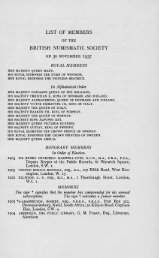

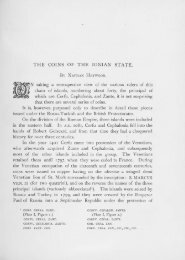
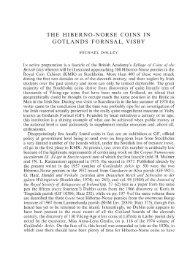
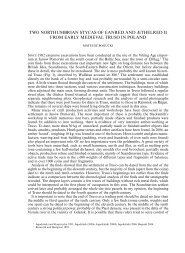

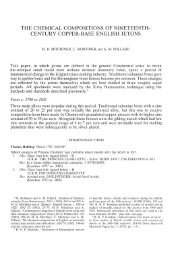
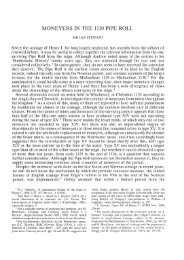
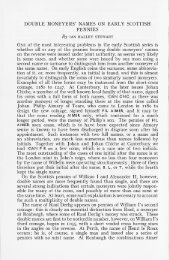
![Two Anglo-Saxon notes: [1] A Cnut die-link between the mints of ...](https://img.yumpu.com/15433998/1/189x260/two-anglo-saxon-notes-1-a-cnut-die-link-between-the-mints-of-.jpg?quality=85)
